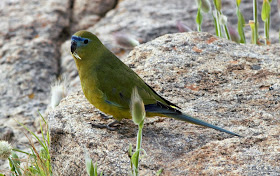 |
| Providence Petrel |
We departed
Mooloolaba Marina at 6.25am on Sunday November 11, 2018 under sunny
skies with an unusually cool south-easterly (for this time of year)
that kept up for the rest of the day at 10-15 knots. As we headed
east we encountered a few small groups of migrating Short-tailed
Shearwaters heading south and several Wedge-tailed Shearwaters before
coming across an unusual congregation of four Pomarine Jaegers over
the Barwon Banks.
 |
| Pomarine Jaeger flock |
We stopped over the
shelf at 9am in 600m, 32 nautical miles offshore (26.42.645 S;
153.42.689E), where we began laying a berley trail. A mild swell of
about a metre and a small chop in the sea with steady winds made for
pleasant conditions. We saw our first Providence Petrel shortly
before stopping and quite a few were about out there,
although it is getting late in the year for this species.
 |
| Providence Petrel |
We had a new berley
mix with extra tuna oil and finely chopped chicken skins that float
well. We soon had a good slick behind the boat which was checked out
by the odd Wilson's Storm-Petrel. The birds generally however did not
appear to be hungry.
 |
| Wilson's Storm-Petrel |
We saw more
Short-tailed and Wedge-tailed shearwaters as the morning progressed
and a Sooty Tern turned up.
 |
| Short-tailed Shearwater |
 |
| Sooty Tern |
We had just two
Tahiti Petrels for the day, a surprisingly small tally. Also of
interest was the very small number of Crested Terns.
 |
| Tahiti Petrel |
Another Pomarine
Jaeger showed before we turned around at 12.30pm after drifting 4
nautical miles to 350m. We stopped a couple of times on the way back
to try our luck. We had a couple of Brown Boobies perched atop a
trawler and a single Flesh-footed Shearwater, along with more
Short-tailed and Wedge-tailed Shearwaters. We returned to the marina
at 3.25pm.
 |
| Brown Booby |
PARTICIPANTS: Paul
Beer (skipper), Zoe Williams (deckhand), Greg Roberts (organiser),
Louis Backstrom,
Margie Baker, Tony Baker, Jane Cooksley, Jo Culican, Robyn Duff,
Cecile Espigole, Paul Fraser, Richard Fuller, John Gunning,
Nikolas Haass, Christian Haass, James Hermans, Andy Jensen, Sel
Kerans, James Martin, William Price, Trevor Ross, Esme Ross,
Raja Stephenson, Carolyn Stewart.
SPECIES: TOTAL
(Maximum at one time)
Providence Petrel 25
(4)
Tahiti Petrel 2 (1)
Short-tailed
Shearwater 80 (20)
Wedge-tailed
Shearwater 30 (3)
Flesh-footed
Shearwater 1 (1)
Wilson's
Storm-Petrel 12 (3)
Brown Booby 2 (2)
Pomarine Jaeger 5 (1)
Sooty Tern 1 (1)
Crested Term 2 (1)
Offshore
Bottle-nosed Dolphin 3 (2)







































































